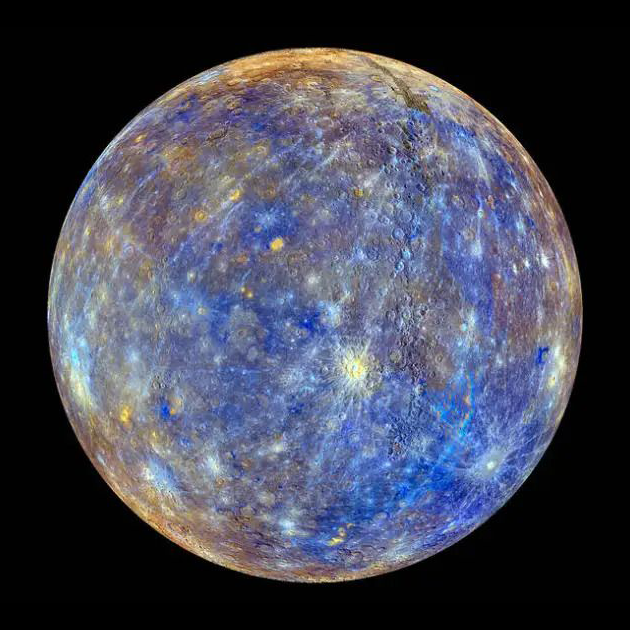Mercury is the first of the eight planets in our solar system, this means it is the closest planet to the Sun. But it is not the hottest planet as you may think (because it lacks an atmosphere that retains the heat).

Table of Contents
Remarkable data about Mercury:
| Radius | 2,439.7 km |
| Mass | 3.301 × 10^23 kg |
| Gravity | 3.7 m/s² |
| Distance from Sun | 57.9 million km |
| Age | 4.503 billion years |
| Orbital period | 87.97 days |
| Natural satellites | None |
Key Features of Mercury:
- Terrestrial Planet: Mercury is a rocky planet with a dense iron core, similar in structure to Earth and other terrestrial planets.
- Smallest planet in the Solar System: it has a diameter of about 4,880 km (3,032 miles), making it only about 38% the size of Earth. Its mass is about 5.5% that of Earth.
- Heavily Cratered Surface: Mercury’s surface is covered with impact craters of various sizes, similar to the Moon’s surface. Notable craters include the Caloris Basin, one of the largest impact basins in the Solar System, with a diameter of about 1,550 km (960 miles).
- Thin Exosphere: Mercury has an extremely thin atmosphere, called an exosphere, composed mainly of atoms blasted off its surface by the solar wind. It contains oxygen, sodium, hydrogen, helium, and potassium.
- Lack of True Atmosphere: Due to its weak gravity and proximity to the Sun, Mercury cannot retain a significant atmosphere, leading to extreme temperature fluctuations between day and night.
- Wide Temperature Range: Mercury experiences the most significant temperature variation of any planet in the Solar System. Daytime temperatures can reach up to 430°C (800°F), while nighttime temperatures can drop to -180°C (-290°F). This is due to the thin exosphere and the absence of an insulating atmosphere.
- Wide Temperature Range: Mercury experiences the most significant temperature variation of any planet in the Solar System. Daytime temperatures can reach up to 430°C (800°F), while nighttime temperatures can drop to -180°C (-290°F). This is due to the thin exosphere and the absence of an insulating atmosphere.
- Presence of Water Ice: Despite its proximity to the Sun, water ice has been detected in the permanently shadowed craters at Mercury’s north and south poles. These regions, shielded from the Sun’s heat, provide cold traps where ice can persist.
Mercury Position in the Solar System:
- Orbit: it orbits the Sun at an average distance of about 36 million miles (57.9 million km), which is a third of the distance from the Earth to the Sun, making this planet extremely hot. But as mentioned before, it is also freezing at night, due to a lack of atmosphere.
- Rotation and Tilt: it rotates on its axis once every 59 days, making it one the slowest planets on making a rotation over its axis. The planet is tilted at about 0.034 degrees, making it nearly perpendicular to to its orbital plane, for this reason it does not experience seasons like here on Earth or on Mars.
